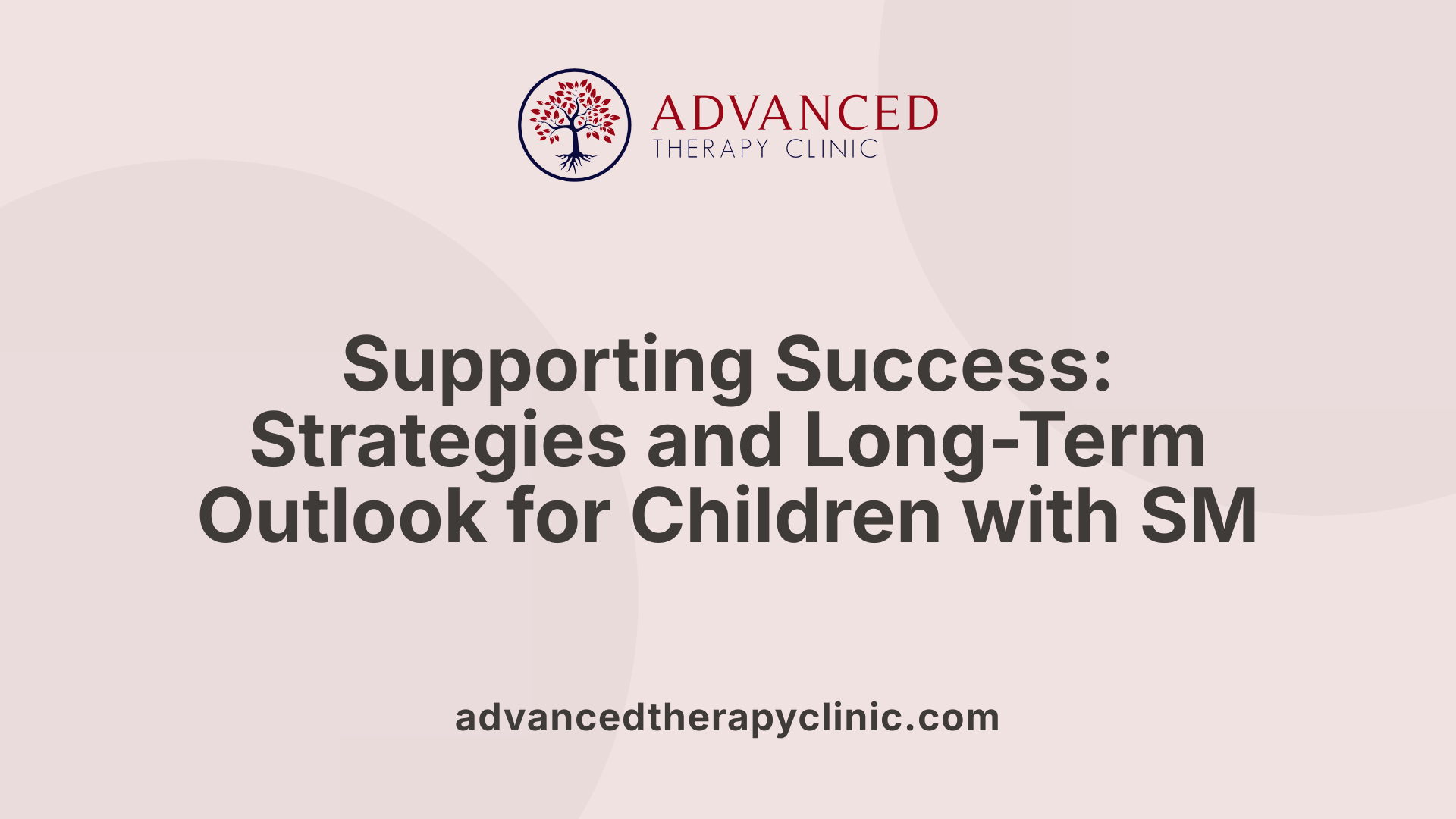How Speech Therapy Assists Children with Selective Mutism


Understanding Selective Mutism and Its Impact on Children
Selective mutism is a complex childhood anxiety disorder that significantly impairs a child's ability to speak in specific social settings, despite speaking normally at home or in familiar environments. Recognized typically between ages 3 and 6, this condition affects approximately 2% of kindergarten children, with a higher prevalence in girls. The silent periods observed in affected children are not due to defiance or stubbornness, but are manifestations of intense social anxiety. If untreated, it can lead to social isolation and long-term communication difficulties, underscoring the importance of early diagnosis and intervention.
What is Selective Mutism and Its Characteristics?

What is selective mutism and what are its characteristics?
Selective mutism is a childhood anxiety disorder marked by a child's persistent inability to speak in specific social situations where speaking is expected, such as at school or in social gatherings, despite being able to speak comfortably at home or with familiar people. Typically beginning between ages 3 and 6, this condition is often linked to intense fears and social anxiety. Children with SM are not deliberately refusing to communicate; rather, their silence is driven by overwhelming anxiety and fear.
Symptoms involve a variety of behaviors, including complete silence in certain environments, reliance on gestures or other nonverbal cues instead of speech, and physical signs like freezing, avoiding eye contact, and withdrawal from interaction. Some children may whisper or speak very softly when they do speak, and their behaviors are usually responses to significant social stress.
The impacts of SM extend beyond silenced speech. Affected children often experience social challenges, such as difficulty forming friendships, participating in group activities, or engaging in classroom discussions. Without proper treatment, these difficulties can persist into adolescence and adulthood, affecting academic performance and social development.
Diagnosis requires careful assessment by qualified professionals, including psychologists and speech-language pathologists, who evaluate communication patterns, observe the child's behavior in different settings, and gather input from parents and teachers. Effective treatments involve behavioral therapies tailored to each child's needs, environmental modifications to reduce anxiety, and in some cases, medication. Early intervention is critical, as it greatly improves the chances of overcoming the disorder and enabling children to communicate confidently across various social contexts.
Signs and Symptoms of Selective Mutism in Children
What are the common signs and symptoms of selective mutism in children?
Children with selective mutism often show a clear pattern of not speaking in specific social contexts, such as at school, during social events, or with unfamiliar adults, even though they can speak normally at home or in environments where they feel comfortable. These children frequently demonstrate social anxiety, which is evident through behaviors like avoiding eye contact, trembling, or appearing very tense.
Physical cues of anxiety are common, including fidgeting, stiff body posture, or avoiding social interaction. They might respond to questions with silence, a single word, or a sound rather than speech. Sometimes, children resort to gesturing, miming, or using write-and-point methods instead of speaking.
The behaviors indicating anxiety and discomfort are often accompanied by social withdrawal, clinginess, or signs of excessive shyness. Children may refuse to speak when asked directly, clutch objects tightly, or display physical symptoms like stomachaches, headaches, or nausea before attending school or social engagements.
This silence and withdrawal are not due to a refusal or stubbornness but are driven by intense fear and social anxiety. Symptoms tend to appear early in life, often around age 3 or 4, and can persist if untreated, impacting social and educational development.
Overall, these signs signal a child's struggle with anxiety in social situations and require sensitive assessment and targeted intervention to support their communication efforts.
Causes and Risk Factors Associated with Selective Mutism
What causes and what are the risk factors associated with selective mutism?
The origins of selective mutism are complex and not entirely understood. Research suggests that a mix of genetic, environmental, and neurological elements play a role.
Genetic and family influences can predispose some children to developing this condition. Children with a family history of anxiety, speech, or communication disorders are at higher risk. Their temperament often features shyness or extreme behavioral inhibition, making them more sensitive to social anxiety.
Environmental factors also significantly impact the development of selective mutism. Experiences such as bullying, traumatic events, or stressful social circumstances can trigger or reinforce silence in children. These stressors may lead to heightened fear or anxiety in social situations, which can escalate to mutism.
Neurological factors involve the brain's response to social stimuli. For some children, a lower threshold of excitability in the amygdala—an area involved with fear processing—may cause exaggerated anxiety response in social contexts. This heightened anxiety is a core component in the manifestation of mutism.
Additional contributors include language delays, bilingual backgrounds, and behavioral patterns reinforced by negative reinforcement strategies. For example, avoiding speaking in certain situations can inadvertently maintain the child’s silence, making treatment more challenging.
Understanding these factors helps guide assessment and intervention, emphasizing a comprehensive approach that considers both biological and environmental influences.
Diagnostic Process and Assessment Methods for Selective Mutism

How is selective mutism diagnosed and what assessment methods are used?
Diagnosing selective mutism involves a thorough evaluation conducted by professionals trained in childhood anxiety and communication disorders. The process begins with collecting detailed developmental, medical, and social histories through interviews with parents, teachers, and caregivers.
To gain a comprehensive understanding of the child's communication patterns, clinicians observe behavior across different settings such as home and school. These observations help determine if the child's silence is context-specific and consistent.
Standardized assessment tools are commonly employed to measure the severity and characteristics of mutism. The Selective Mutism Questionnaire (SMQ) evaluates the frequency of speaking behaviors across environments, while the School Speech Questionnaire (SSQ) provides insights into the child's communication at school.
Clinical interviews, like the Anxiety Disorders Interview Schedule (ADIS), aid in identifying associated anxiety symptoms and ruling out other conditions. Video recordings of interactions in natural environments offer additional data and help assess nonverbal cues.
Speech and language assessments are crucial to differentiate mutism from speech or language impairments. Hearing screenings are also performed to exclude hearing loss as a contributing factor.
Diagnosis follows criteria outlined in the DSM-5, which specify a persistent inability to speak in certain social settings for at least one month. The evaluation also considers the child's social functioning and ensures other disorders such as autism spectrum disorder or language barriers are ruled out.
This comprehensive approach ensures accurate diagnosis and informs tailored intervention strategies to support the child's communication development.
Treatment Options for Children with Selective Mutism, Including Speech Therapy

What treatment options are available for children with selective mutism, including speech therapy?
Children diagnosed with selective mutism benefit from a range of tailored interventions aimed at reducing anxiety and fostering communication. Behavioral treatments are often the first line of intervention, emphasizing gradual exposure to speaking situations through strategies such as stimulus fading, shaping, and positive reinforcement. These methods create a supportive environment where children can build confidence at their own pace.
Cognitive-behavioral therapy (CBT) complements behavioral techniques by helping children understand and manage their anxiety related to speaking. CBT often includes components like social skills training, systematic desensitization, and challenging negative thoughts or beliefs that may hinder communication.
Speech therapy plays a crucial role by focusing on improving speech production and pragmatic language skills. Techniques like the Ritual Sound Approach® (RSA) involve reinforcing voiceless sounds and gradually shaping speech from nonverbal cues to spoken words. Therapists may also employ video modeling, where children view recordings of themselves speaking fluently, to boost confidence and reduce speaking-related anxiety.
In more severe or persistent cases, medications such as selective serotonin reuptake inhibitors (SSRIs) may be prescribed, often in conjunction with therapy. These medications can help alleviate anxiety symptoms, making therapy more effective.
Successful intervention typically requires early diagnosis and a multidisciplinary approach involving speech-language pathologists, psychologists, caregivers, and teachers. Together, they develop comprehensive plans that support the child's needs across different settings.
In summary, effective treatment combines behavioral and cognitive-behavioral techniques with speech therapy goals, and may include medication when appropriate. Early, consistent intervention enhances the chances of overcoming or greatly reducing the impact of selective mutism on a child's social and academic life.
Techniques and Strategies Used in Speech Therapy for Selective Mutism
What techniques and strategies are used in speech therapy for children with selective mutism?
Speech therapy for children with selective mutism incorporates a variety of approaches aimed at reducing anxiety and gradually building confidence in verbal communication. Central to these strategies are stimulus fading and shaping, which involve systematically reducing the environmental barriers and encouraging verbal responses step by step.
Stimulus fading is a technique where the therapist gradually introduces the child to speaking in more challenging settings by starting with familiar and comfortable environments. For example, therapy might begin with non-verbal interactions and slowly progress to structured verbal tasks involving more unfamiliar people and settings. Shaping involves reinforcing any attempt at communication—such as gestures, nods, or tentative sounds—and gradually encouraging more complex verbalizations. This process helps the child develop speaking behaviors at their own pace.
Self-modeling, especially augmented self-modeling, is another powerful strategy. In this approach, children watch videos of themselves engaging in positive verbal exchanges, which reinforce their ability to speak and foster confidence. These videos often capture moments of successful speaking efforts, and seeing themselves succeed helps diminish anxiety and motivates further verbal attempts.
Speech therapists often employ behavioral and cognitive techniques like systematic desensitization, where children are exposed to speaking tasks in a safe, controlled manner, reducing their fear responses. Positive reinforcement, such as praise or small incentives, encourages children to continue practicing speaking behaviors.
Gradual exposure is achieved through a hierarchical structure of speech tasks, starting from easy non-verbal gestures to spontaneous speech in real-world situations. This hierarchy allows children to master each stage comfortably, minimizing stress and promoting success.
Team collaboration is crucial; speech-language pathologists work closely with psychologists, teachers, and families to ensure strategies are consistent across environments. Tailoring interventions to each child's specific needs and readiness levels results in more effective treatment outcomes.
In summary, speech therapy for selective mutism relies heavily on gentle, systematic techniques designed to create a positive, pressure-free environment. Techniques like stimulus fading, shaping, self-modeling, and staged exposure are integrated into a comprehensive plan aimed at gradually transforming silent children into confident speakers.
Role of Speech-Language Pathologists in Managing Selective Mutism

What is the role of speech-language pathologists in managing and treating selective mutism?
Speech-language pathologists (SLPs) are vital in helping children who experience selective mutism, a condition where a child is unable to speak in certain social settings despite speaking normally elsewhere. Their primary role involves performing thorough assessments to understand each child's unique speech, language, and communication needs. This evaluation includes informal observations, standardized tests, language screenings, and input from caregivers and teachers.
Once assessed, SLPs develop tailored treatment plans that target reducing anxiety and building the child's confidence in speaking situations. These plans incorporate various strategies like behavioral techniques—such as gradual exposure and shaping speech from gestures to spoken words—and speech therapy approaches that improve social communication, pragmatic language, and expressive skills.
SLPs often use play-based activities, social stories, role-playing, and self-modeling techniques, including videos of children speaking fluently, to motivate and support children in making progress. They focus on creating a safe and pressure-free environment where the child can practice communication at their own pace.
A crucial part of their role is collaboration. SLPs work closely with families, teachers, psychologists, and other specialists to ensure consistency of strategies across home, school, and therapy settings. This collaboration fosters a supportive network that reinforces the child's progress.
In addition, SLPs educate caregivers and educators about the nature of selective mutism, filling them in on effective reinforcement techniques, environmental modifications, and ways to support the child's communication efforts outside formal therapy sessions. Their holistic approach aims to gradually decrease the child's anxiety, foster positive social interactions, and ultimately help the child communicate freely in all settings.
Benefits of Speech Therapy for Children with Selective Mutism and Supporting Strategies
How can speech therapy help children overcome selective mutism and what are the benefits?
Speech therapy plays a vital role in helping children with selective mutism (SM) by creating a supportive environment that gradually encourages verbal communication. Therapists assess each child's unique speech and language needs, employing techniques such as stimulus fading, shaping, and augmented self-modeling. These methods aim to reduce anxiety, build confidence, and facilitate step-by-step language use.
One effective approach is the Ritual Sound Approach® (RSA), which emphasizes the use of voiceless sounds to reinforce oral movements, slowly progressing toward actual word production. This, along with exposure-based practices, allows children to become more comfortable speaking in new environments. Therapists also utilize behavioral strategies like positive reinforcement and response shaping, focusing on reinforcing small successes to foster further progress.
Early intervention is crucial. Speech-language pathologists often work within a team of psychologists and family members to deliver comprehensive treatment. This multidisciplinary approach ensures that emotional, behavioral, and speech-related factors are addressed simultaneously.
The primary benefits include improvement in social interactions, enhanced language skills, and a reduction in the fear and anxiety associated with speaking. Over time, children develop greater confidence and willingness to participate verbally in various settings, such as school and community activities. Ultimately, these improvements lead to better emotional well-being, social competence, and quality of life for children with SM.
Supporting Strategies and Long-term Outcomes in Selective Mutism Treatment

What supporting strategies and interventions can be combined with speech therapy for effective treatment?
Effective treatment for children with selective mutism often extends beyond speech therapy alone. Creating a supportive, non-pressuring environment is essential to help children feel safe and reduce anxiety associated with speaking. Behavioral techniques such as stimulus fading, systematic desensitization, and response shaping are frequently employed to gradually increase the child's comfort with verbal communication.
Parental involvement is crucial. Parents are encouraged to praise any verbal or social attempt, even if minimal, and to practice small social interactions at home. They are advised to avoid behaviors that may reinforce silence or avoidance, such as pressuring the child to speak. Teachers and peers can support progress by integrating children into small group activities, pairing them with supportive buddies, and providing accommodations like individualized plans.
Behavioral strategies such as positive reinforcement, structured routines, and reassurance further help to lessen anxiety and promote speech. Incorporating a multidisciplinary team—including speech-language pathologists, psychologists, educators, and families—ensures interventions are well-tailored to the child's needs. This comprehensive approach fosters a gradual, confident shift from nonverbal to verbal communication, increasing the chances of long-term progress.
What is the prognosis and long-term outlook for children with selective mutism after speech therapy?
The outlook for children receiving appropriate speech therapy is generally encouraging. When early diagnosis and intervention are provided, many children show significant improvement during adolescence. Studies indicate that approximately 78% of children with SM experience moderate or substantial recovery, with a substantial number no longer meeting diagnostic criteria as they grow older.
Effective treatments, including behavioral therapy and, in some cases, medication like SSRIs, can significantly reduce symptoms and enhance social and academic functioning. The success of therapy depends on factors such as the child's age at treatment start, severity of symptoms, and family dynamics. The earlier intervention begins, the better the prospects for overcoming or managing the disorder.
However, untreated SM may lead to persistent social and emotional difficulties, underscoring the importance of prompt and sustained treatment efforts. Overall, with a comprehensive, multidisciplinary approach, many children with SM can achieve meaningful communication skills and improved quality of life over the long term.
Empowering Children Through Speech Therapy
Speech therapy is a vital component in helping children with selective mutism overcome communication barriers. By employing a range of behavioral, cognitive, and language techniques, speech-language pathologists create tailored interventions that reduce anxiety, build confidence, and foster social skills. The collaborative effort among therapists, families, and educators promotes consistency and supports generalization across environments, essential for lasting progress. Early intervention leads to promising outcomes, with many children eventually speaking confidently and engaging fully in social, academic, and recreational activities. Recognizing the importance of understanding and addressing selective mutism through speech therapy can transform the lives of these children, opening doors to communication and social interaction that might otherwise remain inaccessible.
References
- Speech Language Therapy and Selective Mutism - SMA
- Selective Mutism - ASHA
- Selective Mutism Speech Therapy and Treatment for Children
- Selective Mutism or Neurodivergent Shutdown? | Talkshop
- Can Speech Therapy Help Selective Mutism? - Does it Go Away?
- Selective mutism - NHS
- Guide to Selective Mutism in Children - Child Mind Institute
- What is Selective Mutism and How Can Speech Pathologists Help?
Recent articles

The Benefits of ABA Therapy for Sibling Relationships and Family Bonds
Strengthening Family Ties Through Applied Behavior Analysis

How Speech Therapy Assists with Improving Verbal and Nonverbal Communication
Unlocking Communication Potential: The Role of Speech Therapy

Supporting Autism During Transitions
Strategies and Therapies to Navigate Transitions for Children with Autism

Low-Functioning Autism
Understanding Support and Therapies for Autism Spectrum Disorder Level 3

How Speech Devices Enhance Communication for Nonverbal Children
Transforming Communication: The Role of Speech Devices for Nonverbal Children

TEACCH Method For Autism
Comprehensive Therapeutic Approaches for Autism Spectrum Disorder

